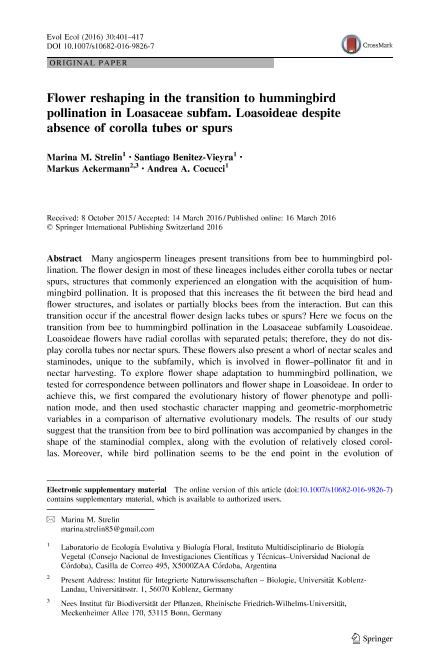Mostrar el registro sencillo del ítem
dc.contributor.author
Strelin, Marina Micaela

dc.contributor.author
Benitez-Vieyra, Santiago Miguel

dc.contributor.author
Ackermann, Markus
dc.contributor.author
Cocucci, Andrea Aristides

dc.date.available
2017-08-29T18:03:23Z
dc.date.issued
2016-03
dc.identifier.citation
Strelin, Marina Micaela; Benitez-Vieyra, Santiago Miguel; Ackermann, Markus; Cocucci, Andrea Aristides; Flower reshaping in the transition to hummingbird pollination in Loasaceae subfam. Loasoideae despite absence of corolla tubes or spurs; Springer; Evolutionary Ecology; 30; 3; 3-2016; 401-417
dc.identifier.issn
0269-7653
dc.identifier.uri
http://hdl.handle.net/11336/23266
dc.description.abstract
Many angiosperm lineages present transitions from bee to hummingbird pollination. The flower design in most of these lineages includes either corolla tubes or nectar spurs, structures that commonly experienced an elongation with the acquisition of hummingbird pollination. It is proposed that this increases the fit between the bird head and flower structures, and isolates or partially blocks bees from the interaction. But can this transition occur if the ancestral flower design lacks tubes or spurs? Here we focus on the transition from bee to hummingbird pollination in the Loasaceae subfamily Loasoideae. Loasoideae flowers have radial corollas with separated petals; therefore, they do not display corolla tubes nor nectar spurs. These flowers also present a whorl of nectar scales and staminodes, unique to the subfamily, which is involved in flower–pollinator fit and in nectar harvesting. To explore flower shape adaptation to hummingbird pollination, we tested for correspondence between pollinators and flower shape in Loasoideae. In order to achieve this, we first compared the evolutionary history of flower phenotype and pollination mode, and then used stochastic character mapping and geometric-morphometric variables in a comparison of alternative evolutionary models. The results of our study suggest that the transition from bee to bird pollination was accompanied by changes in the shape of the staminodial complex, along with the evolution of relatively closed corollas. Moreover, while bird pollination seems to be the end point in the evolution of pollination syndromes in many angiosperm lineages, rodent pollinated flowers probably evolved from ancestral bird pollinated flowers in Loasoideae. Our findings suggest that the evolution of bird pollinated flowers from ancestral bee pollinated flowers does not require the presence of corolla tubes or spurs, and can take place as long as the flower design includes structures participating in flower–pollinator fit.
dc.format
application/pdf
dc.language.iso
eng
dc.publisher
Springer

dc.rights
info:eu-repo/semantics/openAccess
dc.rights.uri
https://creativecommons.org/licenses/by-nc-sa/2.5/ar/
dc.subject
Loasoideae
dc.subject
Pollinator Selection
dc.subject
Hummingbird Pollination
dc.subject
Bee Pollination
dc.subject
Flower Shape
dc.subject.classification
Bioquímica y Biología Molecular

dc.subject.classification
Ciencias Biológicas

dc.subject.classification
CIENCIAS NATURALES Y EXACTAS

dc.subject.classification
Bioquímica y Biología Molecular

dc.subject.classification
Ciencias Biológicas

dc.subject.classification
CIENCIAS NATURALES Y EXACTAS

dc.subject.classification
Bioquímica y Biología Molecular

dc.subject.classification
Ciencias Biológicas

dc.subject.classification
CIENCIAS NATURALES Y EXACTAS

dc.title
Flower reshaping in the transition to hummingbird pollination in Loasaceae subfam. Loasoideae despite absence of corolla tubes or spurs
dc.type
info:eu-repo/semantics/article
dc.type
info:ar-repo/semantics/artículo
dc.type
info:eu-repo/semantics/publishedVersion
dc.date.updated
2017-08-22T14:06:31Z
dc.identifier.eissn
1573-8477
dc.journal.volume
30
dc.journal.number
3
dc.journal.pagination
401-417
dc.journal.pais
Alemania

dc.journal.ciudad
Berlin
dc.description.fil
Fil: Strelin, Marina Micaela. Consejo Nacional de Investigaciones Científicas y Técnicas. Centro Científico Tecnológico Conicet - Córdoba. Instituto Multidisciplinario de Biología Vegetal. Universidad Nacional de Córdoba. Facultad de Ciencias Exactas Físicas y Naturales. Instituto Multidisciplinario de Biología Vegetal; Argentina
dc.description.fil
Fil: Benitez-Vieyra, Santiago Miguel. Consejo Nacional de Investigaciones Científicas y Técnicas. Centro Científico Tecnológico Conicet - Córdoba. Instituto Multidisciplinario de Biología Vegetal. Universidad Nacional de Córdoba. Facultad de Ciencias Exactas Físicas y Naturales. Instituto Multidisciplinario de Biología Vegetal; Argentina
dc.description.fil
Fil: Ackermann, Markus. Universitat KoblenzLandau; Alemania
dc.description.fil
Fil: Cocucci, Andrea Aristides. Consejo Nacional de Investigaciones Científicas y Técnicas. Centro Científico Tecnológico Conicet - Córdoba. Instituto Multidisciplinario de Biología Vegetal. Universidad Nacional de Córdoba. Facultad de Ciencias Exactas Físicas y Naturales. Instituto Multidisciplinario de Biología Vegetal; Argentina
dc.journal.title
Evolutionary Ecology

dc.relation.alternativeid
info:eu-repo/semantics/altIdentifier/url/https://link.springer.com/article/10.1007%2Fs10682-016-9826-7
dc.relation.alternativeid
info:eu-repo/semantics/altIdentifier/doi/http://dx.doi.org/10.1007/s10682-016-9826-7
Archivos asociados
